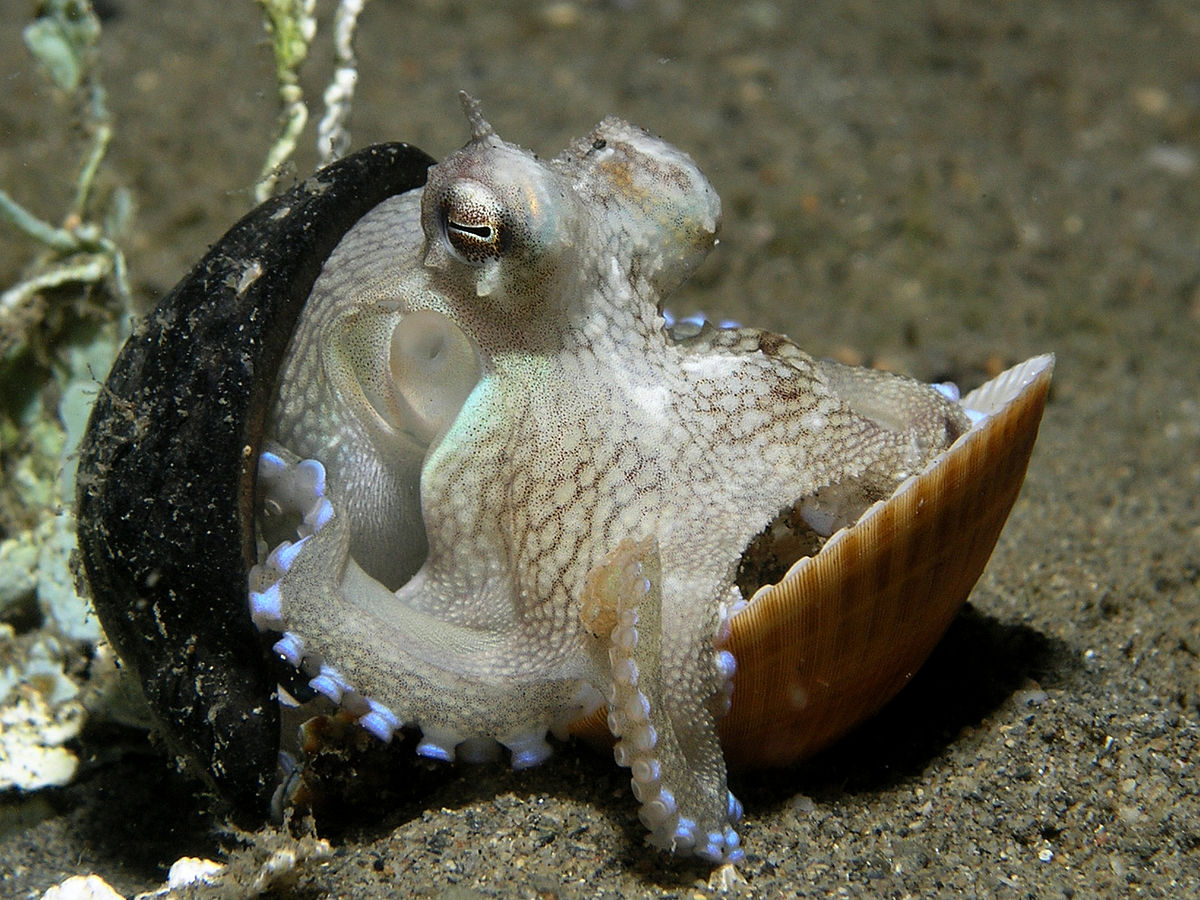The Walking Octopus who Uses Coconuts for Camouflage! [Amazing Creatures of the Deep]
I bet you haven’t heard of a walking octopus before. Nor for an octopus that can use tools for hiding himself and catch his prey. Can you guess why he was nicknamed “Kleptopus”?
Let’s read and find out more about this fascinating, intelligent octopus!
Who is the Coconut Octopus?

Amphioctopus Marginatus is the official name of the medium-sized cephalopods who are also known as coconut-octopus, veined-octopus or some times nicknamed ‘Kleptopus’.
Size of Amphioctopus Marginatus (try saying this outloud if you dare!)
The size of this octopus is approximately 15 centimeters (6 inches) including their arms.
How does the vein octopus look ?
This octopus shows dark lines on its body that look like veins (thus the ‘vein octopus’ name). Its arms are usually dark, while its suckers are of white colour.
Where is the vein octopus found ?
The vein or coconut-octopus lives in the tropical western Pacific & in the Indian Ocean. It is found walking on the sandy bottoms at depths from 0 until 44 meters and occasionally it buries in the sand leaving only its eyes uncovered.
What does it feed on?
They eat shrimps and a variety of clams or crabs.

Mating Behavior
Cephalopoda are gonochoric.
The male perform various activities to attract potential females in order to copulate. During that time, the male fertilizes the eggs, and the embryos hatch into planktonic stage.
Why are we talking about this species?
Many animals use shells as shelters but only this particular species uses tools.
Let us see in detail some of its really bizarre characteristics, that have amazed scientists!
Bipedal Behaviour
In 2005 UC Berkley biologists report a remarkable trick of this species, who lift six of their arms and walk on the remaining two. This is the first report of bipedal behavior in Octopuses.

Coconut – Carrying Octopus
Scientists from Australia discovered a coconut-collector octopus in Indonesia. The octopus collects the coconuts from the ocean bottom, carries them and afterwards assembles to a spherical home-made ned.
"I was gobsmacked," said Finn, a research biologist at the museum who specializes in cephalopods. "I've seen a lot of octopuses hiding in shells, but I've never seen one that grabs it up and jogs across the sea floor. I was trying hard not to laugh."

Many species use shells or tools, but apparently these octopuses are the only ones of their kind that are capable not only for gathering and utilizing, but keep them for later use!
source
There is always debate in the scientific community about how to define "tool use" in the animal kingdom, Robson said. The Australian researchers defined a tool as an object carried or maintained for future use. Other scientists could define it differently, which means it is difficult to say for certain whether this is the first evidence of such behaviour in invertebrates, Robson said.
Still, the findings are interesting, he said: "It's another example where we can think about how similar humans are to the rest of the world. We are just a continuum of the entire planet."

'There is a fundamental difference between picking up a nearby object and putting it over your head as protection versus collecting, arranging, transporting (awkwardly), and assembling portable armour as required,' said Dr Mark Norman, from the Museum Victoria in Melbourne, Australia.

And a little extra : And if you would like to know who an octopus with a British accent looks like, you should make sure to watch this video [2:28 min watch]


Source: News BBC
Source: The Guardian
Source: The Daily Mail
Source: Encyclopedia of Life
Source: Sea Life Base
Source: Berkley Edu
Source: You Tube by Earth Touch
Source: You Tube by Smithsonian Channel

Disclaimer: In case you are wondering if the word octopuses is correct or if the word octopi should be used, please read this for further information on the subject.









Comments